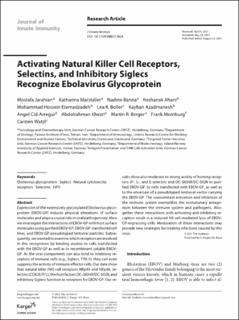| dc.contributor.author | Jarahian, Mostafa | |
| dc.contributor.author | Marstaller, Katharina | |
| dc.contributor.author | Banna, Nadine | |
| dc.contributor.author | Ahani, Roshanak | |
| dc.contributor.author | Etemadzadeh, Mohammad Hossein | |
| dc.contributor.author | Boller, Lea K | |
| dc.contributor.author | Azadmanesh, Kayhan | |
| dc.contributor.author | Cid-Arregui, Angel | |
| dc.contributor.author | Khezri, Abdolrahman | |
| dc.contributor.author | Berger, Martin R | |
| dc.contributor.author | Momburg, Frank | |
| dc.contributor.author | Watzl, Carsten | |
| dc.date.accessioned | 2022-06-21T11:42:27Z | |
| dc.date.available | 2022-06-21T11:42:27Z | |
| dc.date.created | 2021-12-07T15:19:48Z | |
| dc.date.issued | 2021 | |
| dc.identifier.issn | 1662-811X | |
| dc.identifier.uri | https://hdl.handle.net/11250/2999817 | |
| dc.description.abstract | Expression of the extensively glycosylated Ebolavirus glycoprotein (EBOV-GP) induces physical alterations of surface molecules and plays a crucial role in viral pathogenicity. Here we investigate the interactions of EBOV-GP with host surface molecules using purified EBOV-GP, EBOV-GP-transfected cell lines, and EBOV-GP-pseudotyped lentiviral particles. Subsequently, we wanted to examine which receptors are involved in this recognition by binding studies to cells transfected with the EBOV-GP as well as to recombinant soluble EBOV-GP. As the viral components can also bind to inhibitory receptors of immune cells (e.g., Siglecs, TIM-1), they can even suppress the activity of immune effector cells. Our data show that natural killer (NK) cell receptors NKp44 and NKp46, selectins (CD62E/P/L), the host factors DC-SIGNR/DC-SIGN, and inhibitory Siglecs function as receptors for EBOV-GP. Our results show also moderate to strong avidity of homing receptors (P-, L-, and E-selectin) and DC-SIGNR/DC-SIGN to purified EBOV-GP, to cells transfected with EBOV-GP, as well as to the envelope of a pseudotyped lentiviral vector carrying the EBOV-GP. The concomitant activation and inhibition of the immune system exemplifies the evolutionary antagonism between the immune system and pathogens. Altogether these interactions with activating and inhibitory receptors result in a reduced NK cell-mediated lysis of EBOV-GP-expressing cells. Modulation of these interactions may provide new strategies for treating infections caused by this virus. | en_US |
| dc.language.iso | eng | en_US |
| dc.relation.uri | https://doi.org/10.1159/000517628 | |
| dc.rights | Navngivelse 4.0 Internasjonal | * |
| dc.rights.uri | http://creativecommons.org/licenses/by/4.0/deed.no | * |
| dc.subject | Ebolavirus glycoprotein | en_US |
| dc.subject | Siglecs | en_US |
| dc.subject | Natural cytotoxicity receptors | en_US |
| dc.subject | Selectins | en_US |
| dc.subject | HPV | en_US |
| dc.title | Activating Natural Killer Cell Receptors, Selectins, and Inhibitory Siglecs Recognize Ebolavirus Glycoprotein | en_US |
| dc.type | Peer reviewed | en_US |
| dc.type | Journal article | en_US |
| dc.description.version | publishedVersion | en_US |
| dc.subject.nsi | VDP::Matematikk og Naturvitenskap: 400 | en_US |
| dc.source.pagenumber | 135-147 | en_US |
| dc.source.volume | 14 | en_US |
| dc.source.journal | Journal of Innate Immunity | en_US |
| dc.identifier.doi | 10.1159/000517628 | |
| dc.identifier.cristin | 1965731 | |
| cristin.ispublished | true | |
| cristin.fulltext | original | |
| cristin.qualitycode | 1 | |

